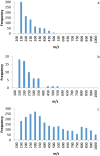Tissue storage affects lipidome profiling in comparison to in vivo microsampling approach
- PMID: 29725071
- PMCID: PMC5934459
- DOI: 10.1038/s41598-018-25428-2
Tissue storage affects lipidome profiling in comparison to in vivo microsampling approach
Abstract
Low-invasive in vivo solid-phase microextraction (SPME) was used to investigate the lipid profiles of muscle tissue of living fish. Briefly, mixed mode SPME fibers were inserted into the muscle for 20 min extraction, and then the fibers were desorbed in an optimal mixture of solvents. The obtained lipid profile was then compared and contrasted to that obtained with employment of ex vivo SPME and solid-liquid extraction (SLE) from fish muscle tissue belonging to the same group of fish, following a one-year storage period. Ex vivo SPME analysis of stored muscle samples revealed 10-fold decrease in the number of detected molecular features in comparison to in vivo study. Moreover, in vivo microsampling enabled the identification of different classes of bioactive lipids, including fatty acyls, not present in the lipid profile obtained through ex vivo SPME and SLE, suggesting the alterations occurring in the unbound lipid fraction of the system under study during the storage and also indicating the advantage of the in vivo extraction approach.
Conflict of interest statement
The authors declare no competing interests.
Figures

Similar articles
-
Exploring sample treatment strategies for untargeted metabolomics: A comparative study of solid phase microextraction (SPME) and homogenization with solid-liquid extraction (SLE) in renal tissue.Anal Chim Acta. 2024 Jul 11;1312:342758. doi: 10.1016/j.aca.2024.342758. Epub 2024 May 21. Anal Chim Acta. 2024. PMID: 38834268
-
Optimization of solid phase microextraction for non-lethal in vivo determination of selected pharmaceuticals in fish muscle using liquid chromatography-mass spectrometry.J Chromatogr A. 2012 Oct 26;1261:99-106. doi: 10.1016/j.chroma.2012.07.053. Epub 2012 Jul 26. J Chromatogr A. 2012. PMID: 22885039
-
Solid-phase microextraction of antibiotics from fish muscle by using MIL-101(Cr)NH2-polyacrylonitrile fiber and their identification by liquid chromatography-tandem mass spectrometry.Anal Chim Acta. 2019 Jan 24;1047:62-70. doi: 10.1016/j.aca.2018.09.060. Epub 2018 Sep 28. Anal Chim Acta. 2019. PMID: 30567665
-
Application of solid-phase microextraction in analytical toxicology.Anal Bioanal Chem. 2007 Aug;388(7):1393-414. doi: 10.1007/s00216-007-1289-9. Epub 2007 May 3. Anal Bioanal Chem. 2007. PMID: 17476482 Review.
-
In vivo solid-phase microextraction for tissue bioanalysis.Bioanalysis. 2012 Nov;4(21):2605-19. doi: 10.4155/bio.12.250. Bioanalysis. 2012. PMID: 23173795 Review.
Cited by
-
Investigating the Potential Use of Chemical Biopsy Devices to Characterize Brain Tumor Lipidomes.Int J Mol Sci. 2022 Mar 24;23(7):3518. doi: 10.3390/ijms23073518. Int J Mol Sci. 2022. PMID: 35408879 Free PMC article.
-
In vivo solid phase microextraction for therapeutic monitoring and pharmacometabolomic fingerprinting of lung during in vivo lung perfusion of FOLFOX.J Pharm Anal. 2023 Oct;13(10):1195-1204. doi: 10.1016/j.jpha.2023.04.005. Epub 2023 Apr 12. J Pharm Anal. 2023. PMID: 38024854 Free PMC article.
-
A Review of Efforts to Improve Lipid Stability during Sample Preparation and Standardization Efforts to Ensure Accuracy in the Reporting of Lipid Measurements.Lipids. 2021 Jan;56(1):3-16. doi: 10.1002/lipd.12263. Epub 2020 Jun 9. Lipids. 2021. PMID: 32519378 Free PMC article. Review.
-
Determination of Brain Tissue Samples Storage Conditions for Reproducible Intraoperative Lipid Profiling.Molecules. 2022 Apr 18;27(8):2587. doi: 10.3390/molecules27082587. Molecules. 2022. PMID: 35458785 Free PMC article.
-
Metabolomic fingerprinting of porcine lung tissue during pre-clinical prolonged ex vivo lung perfusion using in vivo SPME coupled with LC-HRMS.J Pharm Anal. 2022 Aug;12(4):590-600. doi: 10.1016/j.jpha.2022.06.002. Epub 2022 Jun 8. J Pharm Anal. 2022. PMID: 36105172 Free PMC article.
References
-
- Zhao, Y.-Y., Cheng, X. & Lin, R.-C. Chapter One – Lipidomics Applications for Discovering Biomarkers of Diseases in Clinical Chemistry. International Review of Cell and Molecular Biology313 (2014). - PubMed
Publication types
MeSH terms
Substances
LinkOut - more resources
Full Text Sources
Other Literature Sources

